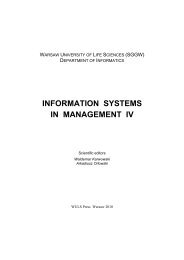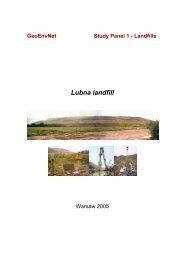112 E. Szymańskatroduced TFI which is derived by comparing the number of bed available to tourists withresident population of the researched area. In this case tourist density is measured.The Tourism Function Index is calculated:TFI = (N · 100)/Pwhere: N = number of bed spaces and P is the population.However, Boniface and Cooper [2009] pay attention to the fact that Defert’s tourismfunction index works good as a measure for holiday resorts but it underestimates theimpact of tourism in cities with a large resident population, or in historic towns that attractlarge numbers of day visitors [Cooper 2009]. Also, it is important to underline thatwhile TFI used to compare variations in accommodation density between regions withinthe same country is very meaningful, at the international level, though, can be misleadingbecause of the differences in definitions and registration requirements among thecountries.Tourism function can be also measured by searching tourism intensity expressed bythe quotient of the number of tourists to the local population (Scheider’s index) or, proposedby Defert, to an area in km 2 (Defert’s index). Another approach described in theliterature is Charvat’s index which examines the amount of beds according to an area.Coccossinis and Parparis [2000] describes some indexes which are less used namely:tourist comfort index based on a formula which distinguishes the quality between differenttypes of accommodation using certain criteria, the concentration index which is anattempt to determine the degree of concentration of tourist activity as well as the attractivenessindex, derived by comparing the number of bed nights between international anddomestic tourists. Attractiveness index can be used in order to evaluate a region’s profilein attracting specific types of tourism overall or by category.For the purpose of evaluating spatial diversification of tourism function in Mazoviaregion the complex approach has been used. The tourism function has been researched inthree aspects: tourism features, tourism movement and tourism values.Two variables have been specified in order to evaluate tourist movement in the researchedregion, namely number of guests staying overnight per 100 inhabitants (Schneider’sindex) and number of guests per km 2 (Defert’s index).Variables examining tourism features have been divided in two groups: beds and tourismservices. The amount of beds is referred to an area in km 2 (Charvat’s index) and to100 inhabitants (TFI) Tourist services are phrased in the amount of enterprises in sectionI and in the share of this objects in the total number of enterprises in the county.While examining tourism features of some area, it is important to take into accountenvironmental factors, which give physical and mental relaxation of tourists and anthropogenicones, such as monuments of history, cultural heritage, collections of art but alsosports centers, events, etc. However, while in case of towns cultural heritage, collectionsof art, sports centers, events are the most important, in peripheral areas environmentalfactors attracts tourists the most. Because of limited statistical data the natural values inthis paper have been specified by percentage of an area protected by law and percentageof forests in the county. Anthropogenic values have been described by number of sitesregistered as historic monuments per area unit. The Table 1 shows the schema of variablesused for the purpose of research.Acta Sci. Pol.
Tourism function of Mazovia Voivodship 113Table 1. Variables for tourism function evaluationTabela 1. Zmienne tworzące wskaźnik poziomu rozwoju funkcji turystycznejTouristmovementTourismfeaturesTourismvaluesSpecificationGuestsBedsTouristservicesin the countyNatural valuesAnthropogenicvaluesVariableNumber of guests staying overnight/100 inhabitantsNumber of guests staying overnight/km 2Number of beds/km 2Number of beds/all inhabitants · 100Number of companies registered in section INumber of companiesregistered in section I/number of all companiesPercentage of area in the county protected by lawPercentage of forestsSource: Own elaboration based on Derek [2008].Źródło: Opracowanie własne na podstawie Derek [2008].Number of sites registered as historic monuments per area unitDatasourceGUSGUSGUSKOBiDZRESULTSThe analyses of tourist movement and tourism features in the counties of Mazoviaregion delivered the following findings. Three counties shows Schneider’s index higherthan average for Poland namely Warsaw, Legionowski and Warsaw West poviat. Relativehigh index has also Pruszkowski poviat, whereas the lowest values show: Ostrołęcki(0), Zwoleński (0) and Lipski poviat. Looking at the number of tourists according tokm 2 (Defert’s index), the highest values, much above the national average, appear inthe poviats: Warsaw, Siedlce, Radom, Ostrołęka, Pruszkowski, Płock, and Legionowski.These are mainly towns with big population or poviats situated near Warsaw. The lowestDefert’s index appears again in the counties: Ostrołęcki (0), Zwoleński (0), Lipski andŻuromiński.Analysing he number of beds per km 2 it can be observed that Warsaw, Siedlce, Radom,Ostrołęka, Płock, Legionowski and Pruszkowski have higher values then average,where Warsaw is definitely a leader. Generally, Defert’s index is connected with relativehigh number of beds. However, sometimes poviats show insufficient use of existing accommodationunits (e.g. Węgrowski). Meanwhile the highest rate of beds according to100 inhabitants (TFI) has Łosicki and Legionowski poviat. The lowest values in thistwo, referring accommodation, groups can be observed in Ostrołęcki (0), Żuromiński (0),Przasnyski, Żyrardowski.Examining the amount of tourism enterprises per 1000 inhabitants it can be observedthat poviats: Warsaw, Legionowski, Warsaw West and Piaseczyński are in front ranks.However, taking into account the average for Poland, the share of these companies in theall enterprises in the poviat is not meaningful. It indicates the fact, that Mazovia showslow scale of tourism companies in compression to other polish regions. The lowest num-Oeconomia 10 (1) 2011
- Page 6 and 7:
6 A. Gawrońska, S. Paszkowskicultu
- Page 8 and 9:
8 A. Gawrońska, S. Paszkowskinumbe
- Page 10 and 11:
10 A. Gawrońska, S. PaszkowskiTabl
- Page 12:
12 A. Gawrońska, S. PaszkowskiTabl
- Page 15 and 16:
The distribution of social security
- Page 17 and 18:
%180,0160,0140,0120,0100,080,060,04
- Page 19:
The distribution of social security
- Page 22 and 23:
22 R. Hryniewski, W. Mądry, D. Goz
- Page 24 and 25:
24 R. Hryniewski, W. Mądry, D. Goz
- Page 26 and 27:
26 R. Hryniewski, W. Mądry, D. Goz
- Page 28 and 29:
28 R. Hryniewski, W. Mądry, D. Goz
- Page 30 and 31:
30 R. Hryniewski, W. Mądry, D. Goz
- Page 32 and 33:
32 R. Hryniewski, W. Mądry, D. Goz
- Page 35 and 36:
Oeconomia 10 (1) 2011, 35-43EDUCATI
- Page 37 and 38:
Education as an element of competit
- Page 39 and 40:
Education as an element of competit
- Page 41 and 42:
Education as an element of competit
- Page 43:
Education as an element of competit
- Page 46 and 47:
46 E. Majewski, P. Sulewski, M. Rag
- Page 48 and 49:
48 E. Majewski, P. Sulewski, M. Rag
- Page 50 and 51:
50 E. Majewski, P. Sulewski, M. Rag
- Page 52 and 53:
52 E. Majewski, P. Sulewski, M. Rag
- Page 54 and 55:
54 E. Majewski, P. Sulewski, M. Rag
- Page 56 and 57:
56 E. Majewski, P. Sulewski, M. Rag
- Page 58 and 59:
58 L. Mazal, K.J. RowlesIn the West
- Page 60 and 61:
60 L. Mazal, K.J. RowlesThe most im
- Page 62 and 63: 62 L. Mazal, K.J. RowlesGDPt= GDP0+
- Page 64 and 65: 64 L. Mazal, K.J. RowlesTHE TIME SE
- Page 66 and 67: 66 L. Mazal, K.J. RowlesTable 4. Ac
- Page 68 and 69: 68 L. Mazal, K.J. RowlesNelson Ch.R
- Page 70 and 71: 70 A. Ptak-Chmielewskastatistics, w
- Page 72 and 73: 72 A. Ptak-Chmielewska3025birth rat
- Page 74 and 75: 74 A. Ptak-ChmielewskaSECTOR OF ACT
- Page 76 and 77: 76 A. Ptak-Chmielewskabirth rate fo
- Page 78 and 79: 78 A. Ptak-Chmielewskawere trade fi
- Page 80 and 81: 80 A. Ptak-ChmielewskaREFERENCESBal
- Page 83 and 84: Oeconomia 10 (1) 2011, 83-95THE EFF
- Page 85 and 86: The effi ciency of selected real es
- Page 87 and 88: The effi ciency of selected real es
- Page 89 and 90: Table 1. Efficiency of real estate
- Page 91 and 92: The effi ciency of selected real es
- Page 93 and 94: The effi ciency of selected real es
- Page 95: The effi ciency of selected real es
- Page 98 and 99: 98 J. Sosnowski, G.A. CiepielaJalin
- Page 100 and 101: 100 J. Sosnowski, G.A. Ciepiela2007
- Page 102 and 103: 102 J. Sosnowski, G.A. CiepielaTabl
- Page 104 and 105: 104 J. Sosnowski, G.A. CiepielaTabl
- Page 106 and 107: 106 J. Sosnowski, G.A. Ciepiela1400
- Page 108 and 109: 108 J. Sosnowski, G.A. CiepielaOsek
- Page 110 and 111: 110 E. SzymańskaProducts by Activi
- Page 114 and 115: 114 E. Szymańskabers of companies
- Page 116 and 117: 116 E. SzymańskaTable 3. Tourism v
- Page 118 and 119: 118 E. SzymańskaREFERENCESCoccossi
- Page 120 and 121: 120 J. WiśniewskaEvery society can
- Page 122 and 123: 122 J. WiśniewskaStatistical analy
- Page 124 and 125: 124 J. WiśniewskaCommon Agricultur
- Page 126 and 127: 126 J. WiśniewskaTable 3. An attem
- Page 128 and 129: 128 J. Wiśniewskathe application o
- Page 130 and 131: 130 J. Wiśniewskainstitutional cos
- Page 132 and 133: 132 J. Wiśniewskaemployed in agric
- Page 134 and 135: 134 J. WiśniewskaLong term viabili
- Page 136 and 137: 136 J. Wiśniewska--The level of re
- Page 139 and 140: Oeconomia 10 (1) 2011, 139-148INNOV
- Page 141 and 142: Innovativeness of food production e
- Page 143 and 144: Innovativeness of food production e
- Page 145 and 146: Innovativeness of food production e
- Page 147 and 148: Innovativeness of food production e
- Page 149 and 150: Oeconomia 10 (1) 2011, 149-158LOCAL
- Page 151 and 152: Local governance activities in supp
- Page 153 and 154: Local governance activities in supp
- Page 155 and 156: Local governance activities in supp
- Page 157 and 158: Local governance activities in supp
- Page 159 and 160: Oeconomia 10 (1) 2011, 159-169CHANG
- Page 161 and 162: Changes in rural women’s movement
- Page 163 and 164:
Changes in rural women’s movement
- Page 165 and 166:
Changes in rural women’s movement
- Page 167 and 168:
Changes in rural women’s movement
- Page 169:
Changes in rural women’s movement
- Page 172:
Ewa SzymańskaTourism function of M
















